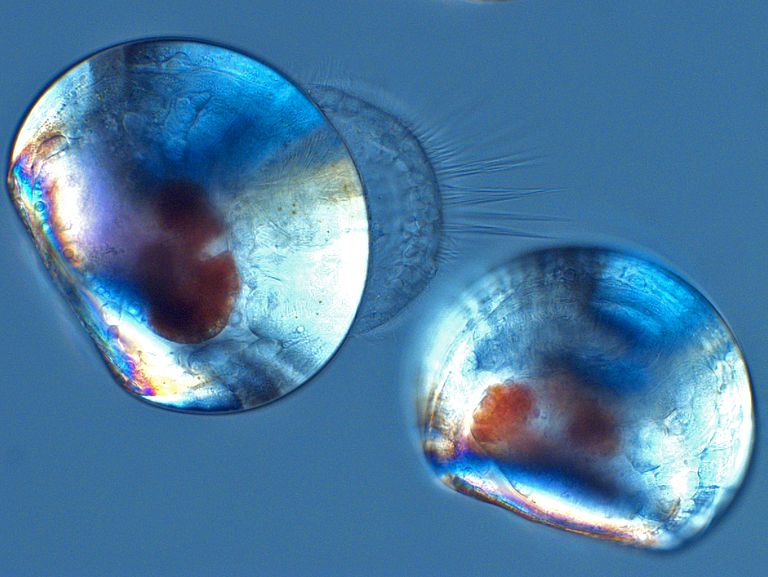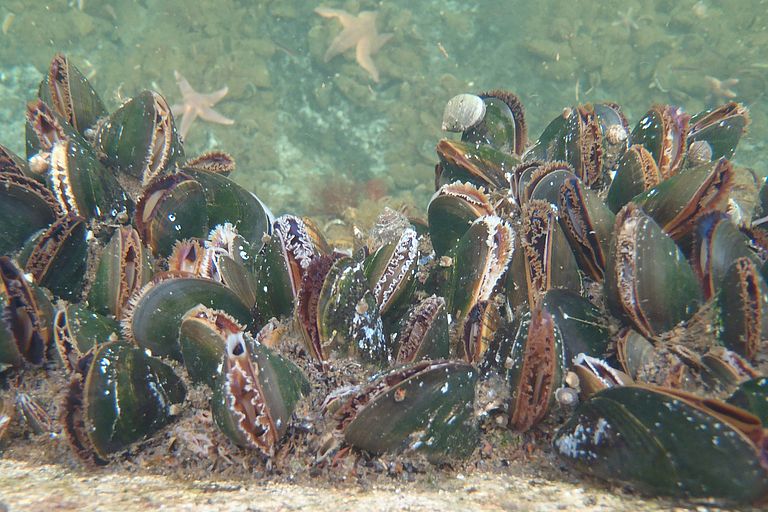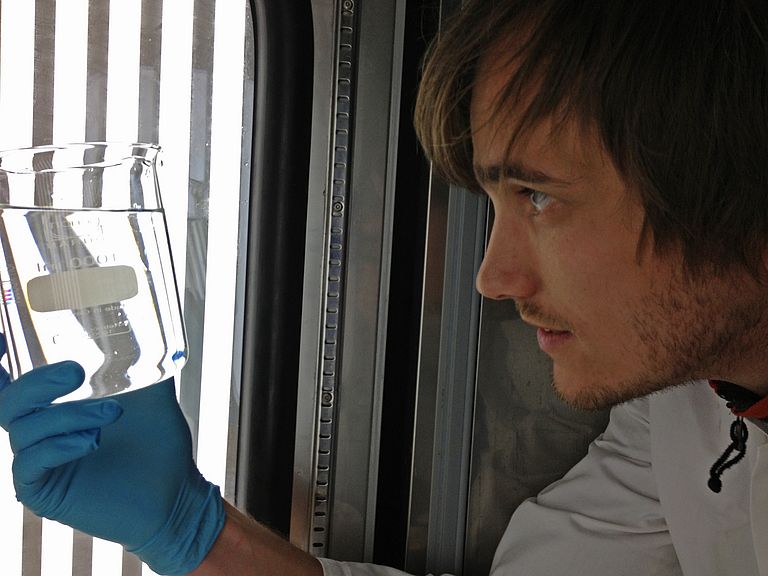The Kiel Fjord – a training pool for blue mussels
Scientists assume genetic adaptation to acidifying waters takes many generations
The Baltic Sea is a unique open-air laboratory for investigations on the effects of ocean acidification, an important aspect of climate change – and apparently also a training pool for the blue mussel Mytilus edulis. During its evolution, the population from the Kiel Fjord has adapted to extreme variations in acidity. In a common garden experiment with elevated carbon dioxide concentrations, Mytilus larvae from the Kiel Fjord formed their first calcareous shells faster than their relatives from the North Sea. Also, far more of them survived. But a complementary three-year multi-generational experiment with mussels from the Kiel Fjord suggests that successful adaptation takes more than just a few generations. The evolution has been going on for several decades, if not centuries or millennia, according to marine biologists from GEOMAR Helmholtz Center for Ocean Research Kiel, Alfred Wegener Institute, Helmholtz Center for Polar and Marine Research, the University of Bremen and Senckenberg am Meer. The results of the two experiments carried out within the German research programme on ocean acidification BIOACID are published in the research journal Science Advances.
For the common garden experiment, mussels from Kiel Fjord were taken to List at the island of Sylt and acclimated to environmental conditions of the North Sea. Their larvae were kept together with larvae of native individuals at today's carbon dioxide concentrations of 390 micro-atmosphere and a very high value of 2400 micro-atmosphere. Carbon dioxide concentrations that are regularly encountered in Kiel Fjord during summer, when the wind pushes water masses low in oxygen and rich in carbon dioxide to the surface. This will happen even more frequently in the future as a result of climate change.
Both larval populations developed their first shell more slowely at higher carbon dioxide concentrations, and the shells initially remained smaller than under normal conditions. But larvae derived from the Kiel mussels were far more robust and survived in larger numbers. “The clear differences between the larvae from Kiel and from Sylt suggest that the long-term genetic adaptation has played a crucial role in their survival and their ability to build their calcareous shells”, emphasizes Dr. Jörn Thomsen, postdoctoral fellow at the working group on ecophysiology at GEOMAR and lead author of the publication. “From previous analyses, we know that the two populations differ genetically.”
The scientists are not able to estimate yet how long the genetic adaptation actually took. “It might have taken place in recent decades when climate change, eutrophication and other factors have led to an increase in acidification and increasing fluctuations in acidity”, explains co-author Dr. Frank Melzner, ecophysiologist at GEOMAR. But it is also possible that the genetic differences that supported the Kiel Fjord mussels in our experiment were developed thousands of years ago. “The lower salinity of the Baltic Sea has always influenced the carbonate system in a similar way as acidification does today. Compared to the North Sea, the Baltic Sea mussels have already needed to adapt to lower concentrations of dissolved calcium carbonate – their bulding blocks for shell formation – for a very long time.”
A multi-generational experiment suggests that on the one hand, that the mussels possess a sufficient genetic diversity to be able to adapt to the more acidified environment. On the other hand, this process does not appear to be completed within a few generations. “Even in the third generation of larvae, we found that the population from the Kiel Fjord was able to compensate for the adverse conditions on the basis of the existing genetic material but their survival has not improved compared to the second generation”, says Dr. Thomsen. Only significantly longer experiments would reveal at which point the resilience is reflected in the genes, how fast adaptation takes place – and whether it can keep up with the current speed of climate change. “In view of our insights, we believe that research should be very cautious with hypotheses about organisms’ ability to adapt based on short experiments with only a few generations”, stresses Dr. Melzner. “Our experiment covered only three generations, but it was one of the longest to date. It clearly shows that much more effort would be needed to really assess the chance of evolutionary adapation to climate change.”
Currently, the researchers are investigating which chemical processes of shell formation require the most energy and which factors hamper them in particular. They hope to learn more about these aspects from studies on populations from the Eastern Baltic Sea. Because salinity there is even lower than at Kiel Fjord, shell formation is especially difficult and the mussels have to be even more robust to survive. Dr. Melzner: “The various basins of the Baltic Sea are characterised by conditions that elsewhere will only occur in many decades. So we can learn a lot from observations in our own backyard – but in order to be able to draw conclusions on future changes, many further analyzes are necessary.”
Reference:
Thomsen, J., Stapp, L. S., Haynert, K., Schade, H., Danelli, M., Lannig, G., Wegner, K. M., and Melzner, F.: Naturally acidified habitat selects for ocean acidification tolerant mussels. Science Advances, doi: 10.1126/sciadv.1602411.
Links:
Alfred Wegener Institute
Senckenberg am Meer
Bremen University
BIOACID – Biological Impacts of Ocean Acidification
Bioacid in brief:
Under the umbrella of BIOACID (Biological Impacts of Ocean Acidification), 10 institutions examine how marine ecosystems react to ocean acidification, how this affects the food web and the exchange of material and energy in the ocean and how the changes influence the socio-economic sector. The project is funded by the Federal Ministry of Education and Research (BMBF) and coordinated by GEOMAR Helmholtz Centre for Ocean Research Kiel. A list of member institutions and further information can be found at www.bioacid.de.
Contact:
Jan Steffen (GEOMAR, Communication & Media), Tel.: (+49) 0431 600-2807, presse(at)geomar.de





